
1950s Murano Glass Peach Blush Chandelier, Sinuous Leaf Forms
A striking Murano glass peach blush glass chandelier, circa 1950s, the tiered chandelier issuing sinuous moulded leaf forms, with a spiral twist stem and a bullicante bowl, 80 cm drop (approx)

Murano Crystal Daffodil Chandelier with Lemon and Gold Colors
A Murano crystal daffodil chandelier, in delicate lemon and gold colours with aventurine inclusions, tiers of serpentine arms and large floriform sconces, embellished throughout with foliage stems of daffodil flowers, 80 cm drop (approx). Provenance: …

Mid-20th Century Murano Glass Chandelier with Hanging Grapes
A vintage Murano glass chandelier with bunches of hanging grapes, early to mid 20th century, 60 cm high, 80 cm wide

Venini Tronchi Chandelier: Monumental Waterfall Form in Clear and Amber
Toni Zuccheri monumental Tronchi chandelier for Venini; waterfall form of four tiers comprised of 64 handblown Murano glass cylinders. Clear and amber glass with textured surface.; Italy; 1960s; 230 cm high, 60 cm deep (approx

Venini Tronchi Chandelier with Three Tiers of Murano Glass
Toni Zuccheri Tronchi chandelier for Venini; three tiers of clear textured Murano glass cylinders.; Italy; c 1960s; 80 cm high, 30 cm deep (approx).

1970s Murano Glass Chandelier with Orange Spheres and Chrome
Murano glass chandelier; orange glass spheres strung on chromed steel frame. Six lights.; Italy; 1970s; 135 cm high, 100 cm deep

Murano Glass Chandelier with Pink Roses and Blue Spirals
A fine Murano glass chandelier, with scrolling arms, pink roses and blue spirals, pendant floral drops and applied leaves, height 90 cm approx, width 60 cm approx.

1960s Mazzega Murano Glass Chandelier, Fully Restored, Italian Pendant
A fully restored Murano glass chandelier for Mazzega, Italian, circa 1960s, the pendant 70 cm drop,

Restored Art Deco Murano Chandelier by Barovier & Toso
A fully restored Art Deco Murano six arm chandelier for Barovier & Toso, circa 1940s, 58 cm drop, 110 cm wide, 73 cm deep, I

Restored Murano Glass Chandelier by Venini, Italian, 1970s
A fully restored Murano glass chandelier for Venini, Italian, circa 1970s

1960s Murano Glass Chandelier with Cascading Textured Droplets
A fully restored vintage Murano glass chandelier, Italian, circa 1960s, constructed out of textured glass droplets created to look like cascading shards, 90 cm drop, 65 cm diameter

1940s Murano Glass Art Deco Chandelier, Fully Restored
A fully restored Art Deco Murano glass four shade chandelier, circa 1940s, 120 cm drop, 90 cm wide, 18 cm deep

Vintage Murano Glass Chandelier by Venini, 1960s, Fully Restored
A fully restored vintage Murano glass chandelier for Venini, circa 1960s, 71 cm high, 51 cm diameter

Restored 1950s Italian Murano Glass Chandelier, Art Deco Style
A fully restored Art Deco Murano glass chandelier, Italian, circa 1950s, 82 cm drop, 57 cm diameter

Carlo Nason Murano Glass Ice Cube Chandelier, Italian 1970s
A Carlo Nason Murano glass ice cube shade chandelier, Italian, circa 1970s, 35 cm drop, 45 cm wide

1970s Murano Glass Chandelier, Fully Restored, Italian, 60cm Drop
A fully restored vintage Murano glass chandelier, Italian, circa 1970s, 60 cm drop, 60 cm diameter

1960s Italian Murano Glass Chandelier Fully Restored 75cm Drop
A fully restored Murano glass chandelier, Italian, circa 1960s, 75 cm drop, 25 cm diameter,

Vintage Murano Glass Chandelier by Seguso, Italian, 1980s/1990s, 80cm Drop
A fully restored vintage Murano glass chandelier for Seguso, Italian, 1980s/1990s, 80 cm drop, 100 cm diameter,

Opalescent Murano Glass Chandelier by Seguso, Italian, 1940s
A fully rewired opalescent Murano glass chandelier for Seguso, Italian, circa 1940s, each of the six branches finished with a coronet form shade, the finial and ceiling rose of conforming design, 90 cm drop, 60 cm diameter,

1940s Italian Art Deco Murano Glass Chandelier by Barovier & Toso
A fully rewired Art Deco Murano glass chandelier for Barovier & Toso, Italian, circa 1940s, 90 cm high, 56 cm diameter,

Restored Mid Century Murano Glass Chandelier by Mazzega Italy
A fully restored mid century Murano glass chandelier for Mazzega, Italian, circa 1970s, 95 cm drop, 45 cm diameter,

Venini Murano Glass Chandelier, 1960s, Fully Restored, 100cm Drop
A fully restored Murano glass four tier chandelier for Venini, Italian, circa 1960s, 100 cm drop, 75 cm diameter at widest point

Mid Century Murano Glass Chandelier, Italian, Circa 1960s
A fully restored mid century Murano glass chandelier, Italian, circa 1960s,

1950s Italian Murano Glass Chandelier by Barovier & Toso
A fully restored Murano glass chandelier for Barovier & Toso, Italian, circa 1950s, 80 cm high, 80 cm diameter,

eModerno Monte Isola Murano Chandelier, Italian, 120 cm drop
A contemporary 'Monte Isola' Italian Murano Chandelier by eModerno, Italian, 120 cm drop, 80 cm diameter,

Restored 1960s Murano Glass Chandelier, Italian Mid Century Lighting
A fully restored mid century Murano glass chandelier, Italian, circa 1960s

Restored 1970s Murano Glass Chandelier by Mazzega, Italian Origin
A fully restored mid century Murano glass chandelier for Mazzega, Italian, circa 1970s,

Restored mid century Murano glass chandelier by Mazzega, 1970s
A fully restored mid century Murano glass chandelier for Mazzega, Italian, circa 1970s,

Restored 1960s Murano Glass Chandelier by Mazzega, Italian Origin
A fully restored mid century Murano glass chandelier for Mazzega, Italian, circa 1960s,

1970s Murano Glass Chandelier by Mazzega, Fully Restored Vintage
A fully restored vintage textured Murano glass chandelier for Mazzega, Italian, circa 1970s, three circular tiers of hanging box section shades, 75 cm high, 45 cm diameter,

Murano Glass Chandelier with Scrolling Ribbons and Hanging Bubbles
A Murano glass chandelier, six light branches, with multiple scrolling ribbons some with hanging 'bubbles', central glass column with decorative detail, the base with conforming decoration and hanging flower bud. 63 x 70 cm.

Colorful Murano Glass Chandelier with Floral Design and Glass Chain
A Murano glass chandelier, six light branches, various coloured scrolling leaf and flower branches, the central column with conforming decoration, a glass chain and flower buds draping from the light branches. Glass drop that hangs from the base of column…

Czech Crystal Marie Therese Chandelier with Murano Droplets, 1960s
A Czech crystal Marie Therese Sixteen-Globe chandelier with rose Murano droplets, 1960s, 110 cm high, 100 cm wide, chain length 40 cm
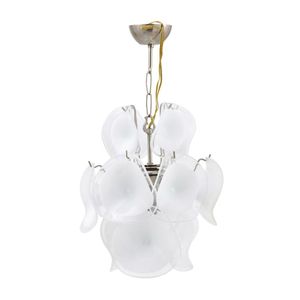
Murano Rondini Chandelier with 14 Glass Petal Elements
Murano Rondini chandelier; 14 transparent and opaque clear glass petal elements suspended from a chromed metal frame. Metal and plastic fittings.; Italy; c 1960s; 55 cm high, 32 cm deep.

Murano Rondini Chandelier with Green and Clear Glass Petals
Murano Rondini chandelier, 18 green and clear transparent glass petal elements suspended from a chromed metal frame. Metal and plastic fittings. Italy, c 1960s, 55 cm high, 37 cm deep

Purple neodymium glass Murano Rondini chandelier with chromed frame
Murano Rondini chandelier, 28 transparent and opaque purple neodymium glass petal elements suspended from a chromed metal frame. Metal and plastic fittings. Italy, c 1960s, 60 cm high, 55 cm deep

Pastel Flower Murano Glass Chandelier with Leafy Stems
A Murano glass chandelier, featuring pastel coloured flowers and leafy stems, the ten scrolling arms with floriferous dishes strung with glass chains and pendants, 90 cm drop, 85 cm diameter approximately

Pair of Red Murano Glass Chandeliers with Scrolled Elements
A near pair of red Murano glass six light chandeliers, each with baluster stem issuing the six scrolled branches and further scrolled elements, colour variations. Height approx 125 cm

Art Deco Venetian Glass Chandelier with Twelve Lights
An Art Deco Venetian glass Twelve-Light chandelier, second quarter 20th century, the upturned lights on individual curving branches emanating from a central stem, each with a vase shaped shade above the bobeche, all variously moulded, the stem and…

Murano Peach Flower Droplet Chandelier: Italian 1970s, Gold Plated
Murano three globe peach flower droplet chandelier, peach coloured flower shaped droplets from a gold plated metal frame, Italy, c 1970s, 48 cm high, 45 cm deep

Murano Iridescent Droplet Chandelier: Gold Plated Frame, c. 1970s
Murano six globe Aurora Borealis droplet chandelier, iridescent coated clear glass droplets. Gold plated frame, Italy, c 1970s, 50 cm high, 45 cm deep

Venini Murano Glass Chandelier
A large Venini chandelier, 1960s, Italy. Five-tiered Murano glass tube chandelier attributed to Venini. A mixture of clear and amber glass tubes supported by metal frame. Dia100 cm

Scarpa Venini Polyhedron Chandelier Installation
Carlo Scarpa Poliedri chandelier for Venini, Murano clear glass polyhedron pendant diffusers with gold coloured metal fittings on a metal frame. Italy, c 1960s, 25 cm high, 58 cm deep. Heavy chandelier deinstallation and installation:
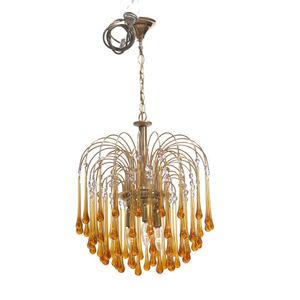
Amber Murano Glass Chandelier with Brass Frame
Venini Murano droplet chandelier, cascading tiers of amber coloured Murano glass droplets and clear crystals suspended from a polished brass frame. Italy, c 1960s, 47 cm high, 41d,

Stylised Murano Glass Chandelier with Coloured Details
A Murano glass chandelier, of six lights on outswept upturned arms amidst stylised leaves, moulded decoration throughout and with coloured details, 83 cm high (overall), 65 cm diameter

Opalescent Glass Chandelier with Pink Flowers
A Venetian opalescent glass small chandelier, five branches and ten flower branches, with pale pink trim and pink flowers, diameter 50 cm.
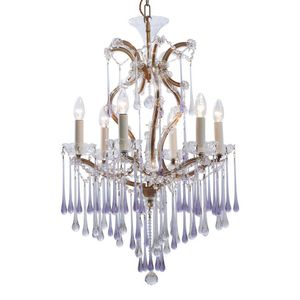
Alexandrite Crystal Chandelier with 6 Lights
A Czech crystal Marie Therese chandelier, of six lights adorned with alexandrite Murano crystal drops, 85 cm high, 56 cm diameter, 125 cm high including chain and canopy
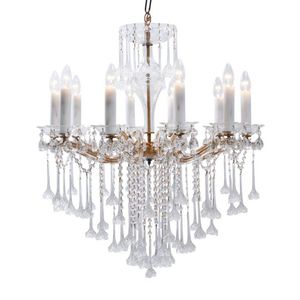
Murano Flower Crystal Chandelier
A Czech crystal Marie Therese chandelier, of ten lights adorned with long Murano glass flower drops, 80 cm high, 70 cm diameter, 125 cm high including chain and canopy
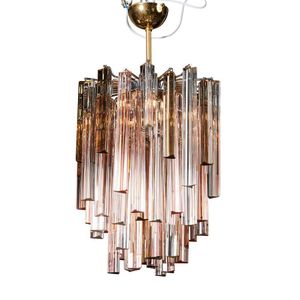
Murano Glass Chandelier in Pink, Amber and Clear Tones
Triedri chandelier for Venini, Murano glass in pale pink, amber and clear tones on a metal frame, Italy, c 1970s,

Frosted Glass Murano Chandelier with Gold Fittings
Vintage Murano chandelier frosted carved glass leaves and gold metal fittings. 35 cm diameter.

Floral Murano Glass Chandelier - 6 Globes
Murano glass 6 globe chandelier with leaf and flower embellishments, 70 cm x 70 cm, 103 cm high

Floral Murano Glass Chandelier with 6 Globes
Murano glass 6 globe chandelier with leaf and flower embellishments, 66 cm x 66 cm, 83 cm high

Murano Glass Chandelier with Floral Embellishments
Very large Murano glass 12 globe chandelier with leaf and flower embellishments, 125 cm x 125 cm, 140 cm high note the glass ceiling rose section is covered with protective wrapping in photos, bottom 10 cm section of glass centre support cover which meets…

Mid-century Czech crystal birdcage chandelier with Murano droplets
A Czech crystal Marie Therese birdcage chandelier, mid 20th century, of birdcage form, central column emanating eight scroll-form branches, adorned with clear and amber Murano droplets by Preciosa, 70 cm high, 129 cm high with canopy, 60 cm diameter.

Barovier & Toso Two-Tiered Venetian Chandelier
A large Two-Tiered Venetian chandelier, by Barovier & Toso, the central column emanating moulded leaves and flowers above six S-form branches with alternating leaves, and a larger lower tier of conforming design emanating ten branches, accented throughout…

Amber Murano Glass Chandelier from Trawalla Estate
A large amber Murano glass chandelier, 134 cm high. Provenance: The contents of Trawalla, Toorak, interior design by the late Stuart Rattle.

Amber-accented Murano glass chandelier with twist 'S' form branches
A Murano glass chandelier, 20th century, the ball and baluster shaft, supporting a bowl emanating eight twist 'S' form branches, with alternating leaves, below alternating flowers and leaves, applied with amber glass accents, 90 cm high (from canopy), 84…

Smoked Crystal Murano Chandelier with 12 Branches
A Murano twelve branch chandelier, 20th century, comprising twelve emanating scroll branches adorned with smoked crystal lustres, 90 cm high (to canopy), 64 cm diameter. Provenance: Purchased from Jean Pierre Heurteau design

Serpentine Murano Glass Chandelier with Floral Appliques
A Murano glass chandelier, circa 1950's, the serpentine pierced basket frame set with applied flower heads, button swags and coloured grape and leaf drops, 86 cm high

Murano Leaf Chandelier, Italy c. 1970s
Italian Murano leaf chandelier, metal with glass formed leaves, Italy, c 1970s
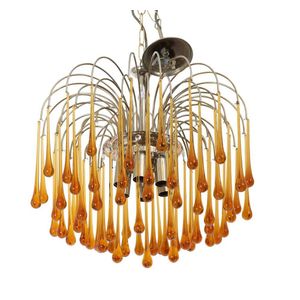
Amber Murano Chandelier, 1970s
Murano droplet chandelier, amber glass droplets on gilt metal frame. Italy, c 1970s, 45 cm high, 48 cm deep

Floral Venetian Glass Chandelier with Six Branches
A Venetian glass chandelier, the whole decorated with floral adornments, the glass stem emanating six flower- form branches alternating, below two tiers of alternating glass leaves and flowers, 123 cm long, 66 cm wide.

1950s Murano Glass Chandelier with Tulip and Foliate Design
Venetian glass chandelier Murano glass, circa 1950s cut glass with tulip and foliate designs drop 90 cm, diameter 60 cm, a/f to one foliate piece

Murano Glass Chandelier with Floral Design
A Murano glass six branch chandelier, circa 1950, the glass stem above a tier of alternating flowers and leaves, above 'S' form branches terminating with moulded bobeches, 100 cm high, 80 cm diameter

Murano Glass Chandelier with Six Branches and Floral Design
A Murano glass six branch chandelier, circa 1950, the glass stem above a tier of alternating flowers and leaves, and a lower tier alternating branches and leaves, 115 cm high, 70 cm diameter

Opalescent Murano Glass Chandelier with Rose Accents
A Murano glass eight branch chandelier, circa 1950, the whole in opalescent glass with rose accents, incorporating alternating leaves and 'S' form branches, 95 cm high, 85 cm diameter

Murano Glass Five Branch Chandelier
A Murano glass five branch chandelier, circa 1950, the central glass stem above 'S' form branches terminating with large bobeches, 72 cm high, 55 cm diameter

1950 Murano Glass Ten Branch Chandelier
A Murano glass ten branch chandelier, circa 1950, the glass stem above a tier of alternating flowers and leaves, and a lower tier of alternating 'S' form branches and leaves, 95 cm high, 100 cm diameter

Gold-inlaid Murano glass chandelier with six branches
A Murano glass six branch chandelier, circa 1950, the whole incorporating gold inclusions, with a tier of glass tendrils above 'S' form branches with vasiform shades, 100 cm high, 70 cm diameter

Amber Murano Chandelier, 1960s Italy
Murano droplet chandelier, amber droplets on brass frame, Italy, c 1960s, 51 cm high, 46 cm deep

Golden Venetian Glass Chandelier with Floral Accents
An impressive Venetian glass chandelier, circa 1960, the whole incorporating gold inclusions, the glass stem emanating ten 'S' shape branches alternating with glass leaves, below two tiers of alternating glass leaves and flowers, 130 cm high, 90 cm…

Art Deco Murano Glass Chandelier with Textured Leaf Throngs
An Art Deco Murano glass chandelier, Barovier and Toso, circa 1930, the air bubble controlled dish eminating fifteen textured glass leaf throngs, approximately 104 cm long

Paolo Venini's Murano Glass Sputnik Chandelier
A Murano glass sputnik chandelier designed by Paolo Venini for VeArt, 1960, 50 cm diameter

Amber Murano Chandelier, Italy, 1970s
Murano droplet chandelier, amber glass droplets, Italy, c 1970s, 40 cm high, 50 cm deep

Amber Murano Chandelier, Italy c. 1970s
Murano droplet chandelier, amber glass droplets, Italy, c 1970s, 40 cm high, 50 cm deep

Grey and Purple Murano Glass Chandelier, 1960s Italy
Mazegga chandelier, grey and purple Murano glass, Italy, c 1960s, 90 cm high, 60 cm deep

Exquisite Venetian Glass Chandelier with Floral Adornments
A Venetian glass chandelier, mid 19th century, the delicate and elaborate hand blown glass chandelier with ten scrolled sconces, each with frilled wax catchers, each arm adorned with link chains and floral encrustations, further decorated with sprays of…
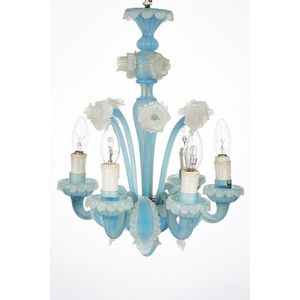
Hand-blown Murano Glass Chandeliers, Blue and Milk Glass
Two Murano glass chandeliers c. 1960 hand blown light blue and milk glass, electrified (2)
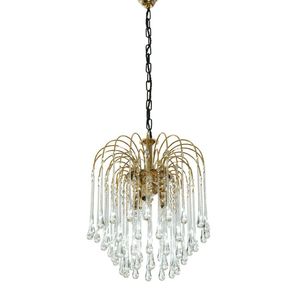
Murano Glass Waterfall Chandelier
Murano waterfall chandelier, Murano glass droplets, Italy, c 1970s, 50 cm high, 30 cm wide

Murano Glass Waterfall Chandelier
Murano waterfall chandelier, Murano glass droplets, Italy, c 1970s, 50 cm high, 30 cm wide

Sciolari Murano Glass Chandelier - 16 Lights
Gaetano Sciolari sixteen light chandelier, Murano glass, chrome and aluminium, Italy, c 1970s, 85 cm high, 74 cm deep. (please note that this piece will require professional removal. We recommend chandelier Therapy [0408 437 279].)
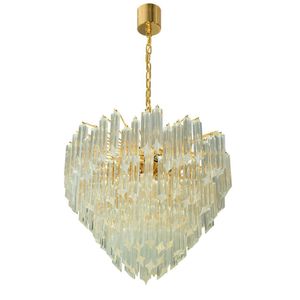
Murano Glass Chandelier with Gilt Frame by Sciolari
Gaetano Sciolari ten light chandelier, Murano glass and gilt frame, Italy, c 1970s, 110 cm high, 54 cm deep. (please note that this piece will require professional removal. We recommend chandelier Therapy [0408 437 279].)

Mazzega Murano Glass Chandelier
Mazzega swirled glass chandelier, sculptured tonal Murano glass on metal frame, Italy, c 1960s, 80 cm high, 60 cm deep. (please note that this piece will require professional removal. We recommend chandelier Therapy [0408 437 279].)

Murano Multi-Branch Chandelier with Crystal Prisms
An impressive Italian Murano multi branch chandelier with storm shades and crystal prisms.
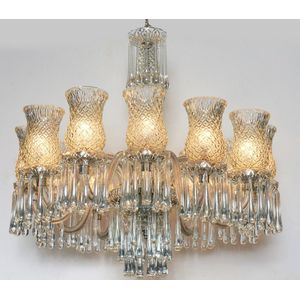
Art Deco Venetian Glass Chandelier with Glass Droplets
An impressive Art Deco Venetian glass chandelier, circa 1920s, having twelve branches with moulded pineapple formed shades, all heavily adorned with glass droplets, emanating from a central stem, the chandelier 78 cm long (not including chain)

Daffodil Murano Glass Chandelier
Murano glass six-light daffodil chandelier 20th century clear and coloured glass, with floral adornments

Floral Murano Glass Chandelier with 6 Lights
Murano glass six-light chandelier early 20th century clear, green and coloured glass, with floral adornments

Clear and Blue Murano Glass Chandeliers (Set of 2)
Murano glass five-light chandelier 20th century clear and blue glass, with floral adornments, together with a three-light clear and blue glass chandelier (2)

Murano Glass Chandeliers with Brass Accents
Mazzega pair of Murano chandeliers; coloured Murano glass and brass (minor chips and crack to glass); Italy; c 1970
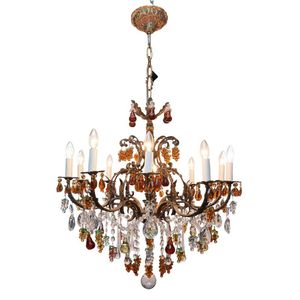
Venetian Fruit Chandelier with Glass and Metal Branches
A Venetian fruit chandelier early 20th century, with ten gilded metal branches adorned with venetian coloured glass fruit and clear droplets 123 cm high including chain, 76 cm diameter

Venetian Amber Marie Therese Chandelier
A Marie Therese chandelier circa 1950, with six branches adorned with Venetian amber droplets. 97 cm high (including chain), 53 cm diameter

Venetian Smoke Glass Chandelier with Swarovski Crystals
A Venetian smoke glass and Swarovski Crystal chandelier circa 1950, with six branches adorned with smoke glass droplets 127 cm high including chain, 60 cm diameter

Murano Glass Daffodil Chandelier
A Murano glass six branch daffodil form chandelier, early 20th century 60 cm high, 60 cm diameter
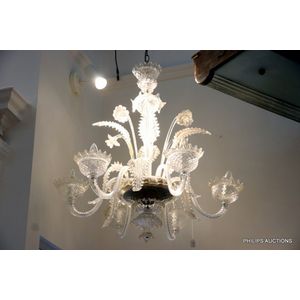
Mid-century Murano Glass Chandelier with Spiral Arms
A fine vintage Murano glass six light chandelier, mid 20th century, the clear glass chandelier having a knopped stem and fine daffodil and fern, frond motifs, six curvaceous spiral twist arms with cup form bobeches in a honey comb quilted decor and…


 Loading more...
Loading more...